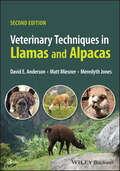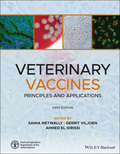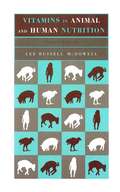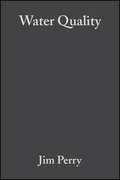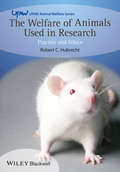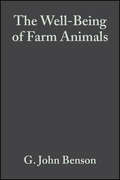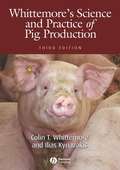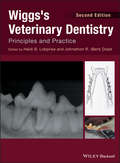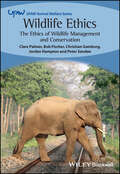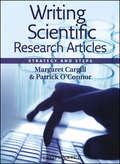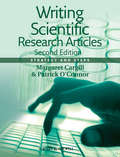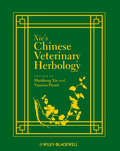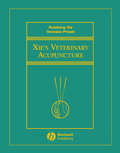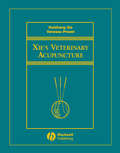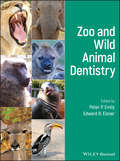- Table View
- List View
Veterinary Techniques in Llamas and Alpacas
by David E. Anderson Matt D. Miesner Meredyth L. JonesVeterinary Techniques in Llamas and Alpacas Practical resource for how-to information on performing hands-on procedures in llamas and alpacas, with step-by-step descriptions, photographs, and practice tips. Thoroughly revised to reflect new techniques, knowledge, and research, the Second Edition of Veterinary Techniques in Llamas and Alpacas provides practical step-by-step descriptions of techniques ranging from routine to not-so-common, helping veterinarians to confidently handle and perform common medical and surgical procedures in llamas and alpacas. To aid in practical application, hundreds of high-quality color photographs demonstrate the steps for each technique, making it a useful patient-side resource. Organized by body system, the book encompasses techniques associated with the physical exam, anesthesia, ultrasound, surgery, and more. Veterinary Techniques in Llamas and Alpacas presents a wide range of techniques, including: Physical restraint and injection sites, including manual restraint (standing, sternal recumbency (“cushed”), and lateral recumbency), chute restraint, and ear squeeze Catheterization, including jugular, cephalic, saphenous, lateral thoracic, auricular vein, auricular artery, femoral artery, intraosseous, intraperitoneal, and caudal epidural The abdomen, including ultrasonography, abdominocentesis, liver biopsy, first forestomach compartment paracentesis, and intubation of the forestomach The female genital system, with information on anatomical considerations, pregnancy diagnosis, vaginoscopy, teat and udder examination, mastectomy, c-section, and uterine torsion The Second Edition of Veterinary Techniques in Llamas and Alpacas is an essential resource for veterinary practitioners with a camelid caseload, with accessible information and detailed picture-based tutorials on how to perform key procedures.
Veterinary Techniques in Llamas and Alpacas
by David E. Anderson Matt Miesner Meredyth JonesVeterinary Techniques in Llamas and Alpacas Practical resource for how-to information on performing hands-on procedures in llamas and alpacas, with step-by-step descriptions, photographs, and practice tips. Thoroughly revised to reflect new techniques, knowledge, and research, the Second Edition of Veterinary Techniques in Llamas and Alpacas provides practical step-by-step descriptions of techniques ranging from routine to not-so-common, helping veterinarians to confidently handle and perform common medical and surgical procedures in llamas and alpacas. To aid in practical application, hundreds of high-quality color photographs demonstrate the steps for each technique, making it a useful patient-side resource. Organized by body system, the book encompasses techniques associated with the physical exam, anesthesia, ultrasound, surgery, and more. Veterinary Techniques in Llamas and Alpacas presents a wide range of techniques, including: Physical restraint and injection sites, including manual restraint (standing, sternal recumbency (“cushed”), and lateral recumbency), chute restraint, and ear squeeze Catheterization, including jugular, cephalic, saphenous, lateral thoracic, auricular vein, auricular artery, femoral artery, intraosseous, intraperitoneal, and caudal epidural The abdomen, including ultrasonography, abdominocentesis, liver biopsy, first forestomach compartment paracentesis, and intubation of the forestomach The female genital system, with information on anatomical considerations, pregnancy diagnosis, vaginoscopy, teat and udder examination, mastectomy, c-section, and uterine torsion The Second Edition of Veterinary Techniques in Llamas and Alpacas is an essential resource for veterinary practitioners with a camelid caseload, with accessible information and detailed picture-based tutorials on how to perform key procedures.
Veterinary Vaccines: Principles and Applications
by Samia Metwally Gerrit Viljoen Ahmed El IdrissiProvides a concise and authoritative reference on the use of vaccines against diseases of livestock Compiled by Senior Animal Health Officers at The Food and Agriculture Organization of the United Nations, and with contributions from international leading experts, Veterinary Vaccines: Principles and Applications is a concise and authoritative reference featuring easily readable reviews of the latest research in vaccinology and vaccine immune response to pathogens of major economic impact to livestock. It covers advice and recommendations for vaccine production, quality control, and effective vaccination schemes including vaccine selection, specifications, vaccination programs, vaccine handling in the field, application, failures, and assessment of herd protection. In addition, the book presents discussions on the current status and potential future developments of vaccines and vaccination against selected transboundary animal diseases. Provides a clear and comprehensive guide on using veterinary vaccines to protect livestock from diseases Teaches the principles of vaccinology and vaccine immune response Highlights the vaccine production schemes and standards for quality control testing Offers easy-to-read reviews of the most current research on the subject Gives readers advice and recommendations on which vaccination schemes are most effective Discusses the today’s state of vaccines and vaccination against selected transboundary animal diseases as well as possible future developments in the field Veterinary Vaccines: Principles and Applications is an important resource for veterinary practitioners, animal health department officials, vaccine scientists, and veterinary students. It will also be of interest to professional associations and NGO active in livestock industry.
Veterinary Vaccines: Principles and Applications
by Samia MetwallyProvides a concise and authoritative reference on the use of vaccines against diseases of livestock Compiled by Senior Animal Health Officers at The Food and Agriculture Organization of the United Nations, and with contributions from international leading experts, Veterinary Vaccines: Principles and Applications is a concise and authoritative reference featuring easily readable reviews of the latest research in vaccinology and vaccine immune response to pathogens of major economic impact to livestock. It covers advice and recommendations for vaccine production, quality control, and effective vaccination schemes including vaccine selection, specifications, vaccination programs, vaccine handling in the field, application, failures, and assessment of herd protection. In addition, the book presents discussions on the current status and potential future developments of vaccines and vaccination against selected transboundary animal diseases. Provides a clear and comprehensive guide on using veterinary vaccines to protect livestock from diseases Teaches the principles of vaccinology and vaccine immune response Highlights the vaccine production schemes and standards for quality control testing Offers easy-to-read reviews of the most current research on the subject Gives readers advice and recommendations on which vaccination schemes are most effective Discusses the today’s state of vaccines and vaccination against selected transboundary animal diseases as well as possible future developments in the field Veterinary Vaccines: Principles and Applications is an important resource for veterinary practitioners, animal health department officials, vaccine scientists, and veterinary students. It will also be of interest to professional associations and NGO active in livestock industry.
Vitamins in Animal and Human Nutrition
by Lee Russell McDowellVitamins in Animal and Human Nutrition contains concise, up-to-date information on vitamin nutrition for both animals and humans. The author defines these nutrients and describes their fascinating discovery, history and relationship to various diseases and deficiencies. Discussion of vitamins also includes their chemical structure, properties and antagonists; analytical procedures; metabolism; functions; requirements; sources; supplementation and toxicity. Vitamin-like substances, essential fatty acids and vitamin supplementation considerations are also examined. This book will be useful worldwide as a textbook and as an authoritative reference for research and extension specialists, feed manufacturers, teachers, students and others. It provides a well-balanced approach to both animal and clinical human nutrition and compares chemical, metabolic and functional aspects of vitamins and their practical and applied considerations. A unique feature of the book is its description of the implications of vitamin deficiencies and excesses and the conditions that might occur in human and various animal species.
Water Quality: Management of a Natural Resource
by Jim Perry Elizabeth Leigh VanderkleinOnce a purely technical sub-discipline of hydrology, water quality management is now a social and political discipline, with concerns ranging from ensuring adequate health standards to preserving biological diversity and ecosystem integrity. This book goes beyond the technical manuals and specialty publications to provide support and guidance for the everyday decisions made by water-quality managers. Water Quality: Management of a Natural Resource addresses the rarely touched upon social, biophysical, land-use and policy considerations, which reflect the issues that confront managers and decision-makers. In a series of incisive reviews, experts address key topics in modern water resource management and case studies illustrate the successes and failures of past management efforts. Water Quality: Management of a Natural Resource develops and presents a management view requiring an awareness of: the social context of management, new ecological theories, and how policy is implemented in different situations and countries.
The Welfare of Animals Used in Research: Practice and Ethics (UFAW Animal Welfare)
by Robert C. HubrechtThe Welfare of Animals used in Research: Practice and Ethics gives a complete and balanced overview of the issues surrounding the use of animals in scientific research. The focus of the book is on the animal welfare implications and ethics of animals in research. It covers the topics with sufficient depth to show a real understanding of varied and complex subjects, but conveys the information in a beautifully reader-friendly manner. Key features: Provides those who are not working in the field with a reasonable understanding as to why and how animals are used in research. Gives an introduction to the ethical issues involved in using animals, and explains how these are addressed in practice. Details the advances in animal welfare and the use and development of the 3Rs principles, and how these have become fundamental to the everyday use and regulation of animals used in research. The focus is on principles making it suitable for an international audience. This book is a useful introduction to the issues involved in laboratory animal welfare for those who intend to work in research involving animals. It is also useful to prospective animal care staff and animal welfare scientists, and to those involved in ethical review. It will help inform debate amongst those who are not involved in experimentation but who are interested in the issues. Published as a part of the prestigious Wiley-Blackwell – UFAW Animal Welfare series. UFAW, founded 1926, is an internationally recognised, independent, scientific and educational animal welfare charity. For full details of all titles available in the series, please visit the UFAW Animal Welfare series website.
The Welfare of Animals Used in Research: Practice and Ethics (UFAW Animal Welfare)
by Robert C. HubrechtThe Welfare of Animals used in Research: Practice and Ethics gives a complete and balanced overview of the issues surrounding the use of animals in scientific research. The focus of the book is on the animal welfare implications and ethics of animals in research. It covers the topics with sufficient depth to show a real understanding of varied and complex subjects, but conveys the information in a beautifully reader-friendly manner. Key features: Provides those who are not working in the field with a reasonable understanding as to why and how animals are used in research. Gives an introduction to the ethical issues involved in using animals, and explains how these are addressed in practice. Details the advances in animal welfare and the use and development of the 3Rs principles, and how these have become fundamental to the everyday use and regulation of animals used in research. The focus is on principles making it suitable for an international audience. This book is a useful introduction to the issues involved in laboratory animal welfare for those who intend to work in research involving animals. It is also useful to prospective animal care staff and animal welfare scientists, and to those involved in ethical review. It will help inform debate amongst those who are not involved in experimentation but who are interested in the issues. Published as a part of the prestigious Wiley-Blackwell – UFAW Animal Welfare series. UFAW, founded 1926, is an internationally recognised, independent, scientific and educational animal welfare charity. For full details of all titles available in the series, please visit the UFAW Animal Welfare series website.
The Well-Being of Farm Animals: Challenges and Solutions
by G. John Benson Bernard E. RollinThe Well-Being of Farm Animals: Challenges and Solutions is the first title in Blackwell Publishing Professional's groundbreaking series Issues in Animal Bioethics. This important book examines the ethical and economic importance of production animal well-being and pain management—topics of increasing concern to consumers. The Well-Being of Farm Animals: Challenges and Solutions offers veterinarians, veterinary and agriculture students, animal scientists, and food animal producers both practical methods to enhance farm animal well-being, and greater understanding of the theoretical underpinnings of those methods. With a variety of perspectives from respected experts and specialists, this book conveys new research findings and promotes valuable discourse on critical issues. Most importantly, editors Benson and Rollin provide feasible instruction to put theory into practice. The theories and applications presented in this book are likely to be legislated in the future. Therefore, it is important for veterinarians in production animal medicine to keep abreast of the latest issues in promoting animal well-being, and implement sound animal welfare methods every day. The Well-Being of Farm Animals: Challenges and Solutions provides the information veterinarians need to do both.
Whittemore's Science and Practice of Pig Production
by Colin T. Whittemore Ilias KyriazakisThe science and practice of pig production has changed rapidly over recent decades; new husbandry practices, new understandings of growth, reproduction and health, new appreciations of welfare and environmental impact, new nutritional approaches, and modern reproductive and genetic techniques have all come into being, together with the emergence of new health challenges. Now in its third edition, this long established reference book on the management, breeding, feeding, nutrition, health and welfare of pigs has been fully revised to provide clear and current information on both the practical and scientific aspects of the pig industry. With the help of a new panel of international experts and a senior editor, the overall structure now contains input from international centres across Europe and North America. This edition includes: Updated versions of existing chapters; Completely revised and new sections on: Pig meat and carcass quality, Reproduction, The maintenance of health, Nutritional value of protein and amino acids in feed stuffs, Value of fats and oils in pig diets, Product marketing, Environmental management, Simulation modelling; Input from international authorities; Many tables, diagrams, photographs and figures.
Wiggs's Veterinary Dentistry: Principles and Practice
by Heidi B. Lobprise Johnathon R. Bert DoddWiggs’s Veterinary Dentistry: Principles and Practice, Second Edition is a fully updated and expanded new edition of the classic comprehensive reference for veterinary dentistry. Provides current, comprehensive information on veterinary dentistry Encompasses rudimentary tenets of the field as well as advanced techniques Presents the state-of-the-art in veterinary dentistry, with all topics fully updated, revised, and expanded to reflect current knowledge Written by leading veterinary dental specialists and edited by luminaries in the field Includes more images and color throughout to support the text
Wiggs's Veterinary Dentistry: Principles and Practice
by Heidi B. Lobprise Johnathon R. DoddWiggs’s Veterinary Dentistry: Principles and Practice, Second Edition is a fully updated and expanded new edition of the classic comprehensive reference for veterinary dentistry. Provides current, comprehensive information on veterinary dentistry Encompasses rudimentary tenets of the field as well as advanced techniques Presents the state-of-the-art in veterinary dentistry, with all topics fully updated, revised, and expanded to reflect current knowledge Written by leading veterinary dental specialists and edited by luminaries in the field Includes more images and color throughout to support the text
Wildlife Ethics: The Ethics of Wildlife Management and Conservation (UFAW Animal Welfare)
by Clare Palmer Bob Fischer Christian Gamborg Jordan Hampton Peter SandoeWildlife Ethics A systematic account of the ethical issues related to wildlife management and conservation Wildlife Ethics is the first systematic, book-length discussion of the ethics of wildlife conservation and management, and examines the key ethical questions and controversies. Tackling both theory and practice, the text is divided into two parts. The first describes key concepts, ethical theories, and management models relating to wildlife; the second puts these concepts, theories, and models to work, illustrating their significance through detailed case studies on controversies in wildlife management and conservation. The book explores pressing topics including human responsibilities due to climate change, tradeoffs when managing zoonotic disease risks, the ethics of the wildlife trade, culling non-native species, indigenous wildlife use, and zoo-based conservation programs. Readers are encouraged to explore different ways of valuing wild animals and their practical implications. This essential text: Explains and explores relationships between valuing biodiversity, human utility, ecosystems, species, and animal welfare Describes established approaches to wildlife management, such as sustainable use, and emerging concepts, such as compassionate conservation Discusses key ethical theories, including utilitarianism, ecocentrism, and animal rights Offers a practical model of how to analyze ethical issues in wildlife management and conservation Wildlife Ethics: The Ethics of Wildlife Management and Conservation is an accessible introduction to complex ethical issues, making the book an important resource for students in fields such as conservation biology, ecology, environmental science and policy, game management, public health and veterinary medicine. It will also be an invaluable tool for wildlife managers, conservationists, One Health practitioners, practicing veterinarians and animal rehabilitation staff, contemporary wildlife professionals and other stakeholders.
Wildlife Ethics: The Ethics of Wildlife Management and Conservation (UFAW Animal Welfare)
by Clare Palmer Bob Fischer Christian Gamborg Jordan Hampton Peter SandoeWildlife Ethics A systematic account of the ethical issues related to wildlife management and conservation Wildlife Ethics is the first systematic, book-length discussion of the ethics of wildlife conservation and management, and examines the key ethical questions and controversies. Tackling both theory and practice, the text is divided into two parts. The first describes key concepts, ethical theories, and management models relating to wildlife; the second puts these concepts, theories, and models to work, illustrating their significance through detailed case studies on controversies in wildlife management and conservation. The book explores pressing topics including human responsibilities due to climate change, tradeoffs when managing zoonotic disease risks, the ethics of the wildlife trade, culling non-native species, indigenous wildlife use, and zoo-based conservation programs. Readers are encouraged to explore different ways of valuing wild animals and their practical implications. This essential text: Explains and explores relationships between valuing biodiversity, human utility, ecosystems, species, and animal welfare Describes established approaches to wildlife management, such as sustainable use, and emerging concepts, such as compassionate conservation Discusses key ethical theories, including utilitarianism, ecocentrism, and animal rights Offers a practical model of how to analyze ethical issues in wildlife management and conservation Wildlife Ethics: The Ethics of Wildlife Management and Conservation is an accessible introduction to complex ethical issues, making the book an important resource for students in fields such as conservation biology, ecology, environmental science and policy, game management, public health and veterinary medicine. It will also be an invaluable tool for wildlife managers, conservationists, One Health practitioners, practicing veterinarians and animal rehabilitation staff, contemporary wildlife professionals and other stakeholders.
Wilson's Practical Meat Inspection
by William G. WilsonAwareness of food safety and its economic significance has never been higher after public alarm following the BSE crisis and the Foot-and-Mouth outbreak. This classic text is an essential handbook for all persons involved in meat inspection and the meat industry seeking information on the latest diseases and parasites. Now in its seventh edition, it has been revised to reflect the latest knowledge of BSE, Foot-and-Mouth and TB. Information on specific diseases, parasites and physiological processes has been updated and the latest legislation included. As well as this, a new chapter on illegal meat imports has been added, with the aim of helping the detection of illegal meat and ensuring its removal from the food chain. Well-established and respected reference for all those seeking hands-on, practical information; Details the latest reports on diseases and includes crucial information on meat related legislation.
Writing Scientific Research Articles: Strategy and Steps
by Margaret Cargill Patrick O'Connor"Margaret Cargill's background as a linguist and research communications educator and Patrick O'Connor's experience as both research scientist and educator synergize to improve both the science and art of scientific writing. If the authors' goal is to give scientists the tools to write and publish compelling, well documented, clear narratives that convey their work honestly and in proper context, they have succeeded admirably." Veterinary Pathology, July 2009 "[The book is] clearly written, has a logical step-by-step structure, is easy to read and contains a lot of sensible advice about how to get scientific work published in international journals. The book is a most useful addition to the literature covering scientific writing." Aquaculture International, April 2009 Writing Scientific Research Articles: Strategy and Steps guides authors in how to write, as well as what to write, to improve their chances of having their articles accepted for publication in international, peer reviewed journals. The book is designed for scientists who use English as a first or an additional language; for research students and those who teach them paper writing skills; and for early-career researchers wanting to hone their skills as authors and mentors. It provides clear processes for selecting target journals and writing each section of a manuscript, starting with the results. The stepwise learning process uses practical exercises to develop writing and data presentation skills through analysis of well-written example papers. Strategies are presented for responding to referee comments, as well as ideas for developing discipline-specific English language skills for manuscript writing. The book is designed for use by individuals or in a class setting. Visit the companion site at www.writeresearch.com.au for more information.
Writing Scientific Research Articles: Strategy and Steps
by Margaret Cargill Patrick O'ConnorThis book shows scientists how to apply their analysis and synthesis skills to overcoming the challenge of how to write, as well as what to write, to maximise their chances of publishing in international scientific journals. The book uses analysis of the scientific article genre to provide clear processes for writing each section of a manuscript, starting with clear ‘story’ construction and packaging of results. Each learning step uses practical exercises to develop writing and data presentation skills based on reader analysis of well-written example papers. Strategies are presented for responding to referee comments, and for developing discipline-specific English language skills for manuscript writing and polishing. The book is designed for scientists who use English as a first or an additional language, and for individual scientists or mentors or a class setting. In response to reader requests, the new edition includes review articles and the full range of research article formats, as well as applying the book’s principles to writing funding applications. Web support for this book is available at www.writeresearch.com.au
Writing Scientific Research Articles: Strategy and Steps
by Margaret Cargill Patrick O'Connor"Margaret Cargill's background as a linguist and research communications educator and Patrick O'Connor's experience as both research scientist and educator synergize to improve both the science and art of scientific writing. If the authors' goal is to give scientists the tools to write and publish compelling, well documented, clear narratives that convey their work honestly and in proper context, they have succeeded admirably." Veterinary Pathology, July 2009 "[The book is] clearly written, has a logical step-by-step structure, is easy to read and contains a lot of sensible advice about how to get scientific work published in international journals. The book is a most useful addition to the literature covering scientific writing." Aquaculture International, April 2009 Writing Scientific Research Articles: Strategy and Steps guides authors in how to write, as well as what to write, to improve their chances of having their articles accepted for publication in international, peer reviewed journals. The book is designed for scientists who use English as a first or an additional language; for research students and those who teach them paper writing skills; and for early-career researchers wanting to hone their skills as authors and mentors. It provides clear processes for selecting target journals and writing each section of a manuscript, starting with the results. The stepwise learning process uses practical exercises to develop writing and data presentation skills through analysis of well-written example papers. Strategies are presented for responding to referee comments, as well as ideas for developing discipline-specific English language skills for manuscript writing. The book is designed for use by individuals or in a class setting. Visit the companion site at www.writeresearch.com.au for more information.
Writing Scientific Research Articles: Strategy and Steps
by Margaret Cargill Patrick O'ConnorThis book shows scientists how to apply their analysis and synthesis skills to overcoming the challenge of how to write, as well as what to write, to maximise their chances of publishing in international scientific journals. The book uses analysis of the scientific article genre to provide clear processes for writing each section of a manuscript, starting with clear ‘story’ construction and packaging of results. Each learning step uses practical exercises to develop writing and data presentation skills based on reader analysis of well-written example papers. Strategies are presented for responding to referee comments, and for developing discipline-specific English language skills for manuscript writing and polishing. The book is designed for scientists who use English as a first or an additional language, and for individual scientists or mentors or a class setting. In response to reader requests, the new edition includes review articles and the full range of research article formats, as well as applying the book’s principles to writing funding applications. Web support for this book is available at www.writeresearch.com.au
Xie's Chinese Veterinary Herbology
by Huisheng Xie Vanessa PreastXie's Chinese Veterinary Herbology serves as a practical guide to the theory and application of Chinese Herbal Medicine into veterinary practices. Divided into three parts, the book covers herbal materia medica used in treating various disorders and diseases, herbal formulas, and the clinical application of treatments. The book also outlines each herb's history, the formulation of herbal recipes, energetic actions, indications and contraindications of each formula, dosages, and clinical and pharmacological studies performed with herbal treatments. This text serves as an invaluable reference to veterinarians looking to expand treatment options.
Xie's Chinese Veterinary Herbology
by Huisheng Xie Vanessa PreastXie's Chinese Veterinary Herbology serves as a practical guide to the theory and application of Chinese Herbal Medicine into veterinary practices. Divided into three parts, the book covers herbal materia medica used in treating various disorders and diseases, herbal formulas, and the clinical application of treatments. The book also outlines each herb's history, the formulation of herbal recipes, energetic actions, indications and contraindications of each formula, dosages, and clinical and pharmacological studies performed with herbal treatments. This text serves as an invaluable reference to veterinarians looking to expand treatment options.
Xie's Veterinary Acupuncture
by Huisheng Xie Vanessa PreastTraditional Chinese Veterinary Medicine has been used to treat animals in China for thousands of years. Until now, the majority of the literature on Traditional Chinese Veterinary Medicine has been written in Chinese. Xie's Veterinary Acupuncture serves as a comprehensive and accessible reference on the basic principles, techniques and clinical application of veterinary acupuncture. Written by a world renowned authority on veterinary acupuncture and a panel of experts, the book incorporates a traditional Chinese approach to veterinary acupuncture, including ancient and newly developed acupuncture techniques for both small and large animals. With the growing interest in veterinary acupuncture worldwide, this ground-breaking and authoritative text is a timely resource for practitioners and students alike.
Xie's Veterinary Acupuncture
by Huisheng Xie Vanessa PreastTraditional Chinese Veterinary Medicine has been used to treat animals in China for thousands of years. Until now, the majority of the literature on Traditional Chinese Veterinary Medicine has been written in Chinese. Xie's Veterinary Acupuncture serves as a comprehensive and accessible reference on the basic principles, techniques and clinical application of veterinary acupuncture. Written by a world renowned authority on veterinary acupuncture and a panel of experts, the book incorporates a traditional Chinese approach to veterinary acupuncture, including ancient and newly developed acupuncture techniques for both small and large animals. With the growing interest in veterinary acupuncture worldwide, this ground-breaking and authoritative text is a timely resource for practitioners and students alike.
Zoo and Wild Animal Dentistry
by Edward R. Eisner Peter P. EmilyZoo and Wild Animal Dentistry is the first book to offer a comprehensive reference to oral pathology and dental therapy in captive and wild exotic animals. Comprehensive in scope, the book is authored by noted experts on the topic who cover dental care for a broad range of species with an emphasis on oral health. Designed as a practical resource for treating exotic animals, the book is filled with instructive photographs and illustrations that clearly depict pathologies and demonstrate techniques. The book draws on the editors’ and contributors’ years of experience with exotic animals to offer a reliable resource to the history of veterinary dentistry, information on the evolution of teeth, practical dental therapeutics, and oral descriptions for each of the more than three hundred species included in the book. Zoo and Wild Animal Dentistry covers a wide range of zoo and wild species, including cats, bears, primates, dogs, raccoons, weasels, hyenas, marsupials, herbivores, edentates, sea mammals, birds, reptiles, and more. This important resource: Offers a comprehensive reference to oral pathology and dental therapy in captive and wild animals Highlights oral health to promote overall health Includes information on the most recent advances in the field Contains a groundbreaking resource for the dental care of exotic animals Written for zoo and wildlife caretakers and veterinarians, veterinary dentists, veterinary technicians, and veterinary students, Zoo and Wild Animal Dentistry is a practical resource that has information for the dental care of a wide range of animal species that are all too often neglected.
Zoo and Wild Animal Dentistry
by Edward R. Eisner Peter P. EmilyZoo and Wild Animal Dentistry is the first book to offer a comprehensive reference to oral pathology and dental therapy in captive and wild exotic animals. Comprehensive in scope, the book is authored by noted experts on the topic who cover dental care for a broad range of species with an emphasis on oral health. Designed as a practical resource for treating exotic animals, the book is filled with instructive photographs and illustrations that clearly depict pathologies and demonstrate techniques. The book draws on the editors’ and contributors’ years of experience with exotic animals to offer a reliable resource to the history of veterinary dentistry, information on the evolution of teeth, practical dental therapeutics, and oral descriptions for each of the more than three hundred species included in the book. Zoo and Wild Animal Dentistry covers a wide range of zoo and wild species, including cats, bears, primates, dogs, raccoons, weasels, hyenas, marsupials, herbivores, edentates, sea mammals, birds, reptiles, and more. This important resource: Offers a comprehensive reference to oral pathology and dental therapy in captive and wild animals Highlights oral health to promote overall health Includes information on the most recent advances in the field Contains a groundbreaking resource for the dental care of exotic animals Written for zoo and wildlife caretakers and veterinarians, veterinary dentists, veterinary technicians, and veterinary students, Zoo and Wild Animal Dentistry is a practical resource that has information for the dental care of a wide range of animal species that are all too often neglected.
